When you start on your digital journey, it’s essential to understand SEO for beginners.
Learning SEO may seem daunting, but with the right resources, it’s easier than you think.
Our guide is aimed at those using WordPress, one of the world’s most popular website platforms.
With the help of a dedicated WordPress SEO plugin, we’ll show you how to make your site stand out, even if you’re entirely new to this field.
Welcome to your introductory guide to SEO for beginners.
Let’s start by defining SEO.
In This Article
What is SEO?
SEO, or search engine optimization, is the art and science of creating high-quality content that attracts and satisfies users and achieves website goals.
Because all online content is indexed and ranked by search engines, learning the basics of SEO is vital to online success.
Can I Teach Myself SEO?
Thanks to online tutorials and software, it’s never been easier to teach yourself SEO.
You can learn SEO fundamentals quickly by using a WordPress plugin. The plugin will automate many tasks and simplify your SEO.
Introducing the Focus Keyphrase
Before we start, you’ll need to know what a focus keyphrase is.
A focus keyphrase is the main topic of your page. SEO will be easier if you choose your focus keyphrase before creating the related page content.
Your focus keyphrase can be one word (like “keto”). But it’s more effective to use a specific phrase, like “keto recipes” or “keto meal prepping.”
After you work through this tutorial, we recommend learning the basics of keyword research.
Learning to do this type of research will help you choose a keyword that’s easy to rank for. And this tactic can help you rank higher in search results.
Other terms for focus keyphrase include focus keyword or target keyword.
Now, let’s get started with SEO for beginners.
SEO for Beginners: How to Get Started
To learn quickly and get results, we recommend using an SEO plugin.
This is where All on One SEO (AIOSEO) comes in. It’s designed for beginners and makes optimizing pages simple.
AIOSEO will analyze your pages and provide a checklist of actions.

For each item that needs improvement, you’ll receive clear steps So, there’s no need for guesswork.
Don’t worry: you don’t need to know code or anything technical. If you can click buttons and fill out form fields, you can use this plugin.
All in One SEO is an established plugin with thousands of 5-star reviews on WordPress.org. Currently, it’s used by over 3 million site owners.
t
Step 1: Download All in One SEO (AIOSEO)
After downloading and installing All in One SEO (AIOSEO), a setup wizard will walk you through a few steps.
Now, you’re ready to take action.
Let’s find the AIOSEO sidebar.
In the WordPress editor, navigate to a page you want to optimize.
Then click on the AIOSEO button at the upper right.
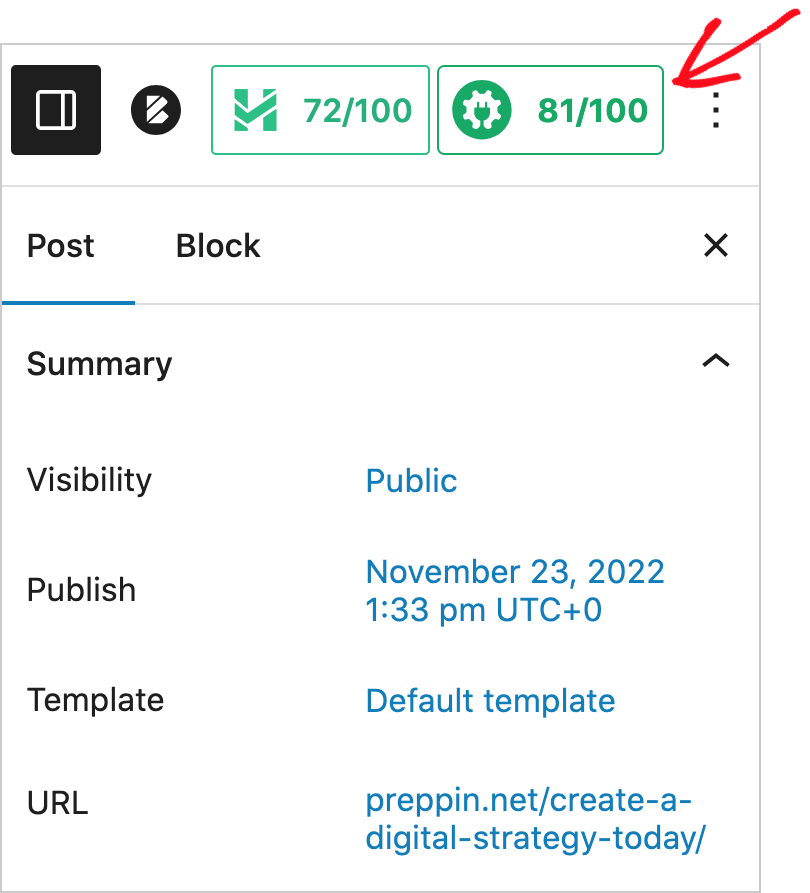
That will open the AIOSEO sidebar.
Next, click on General.
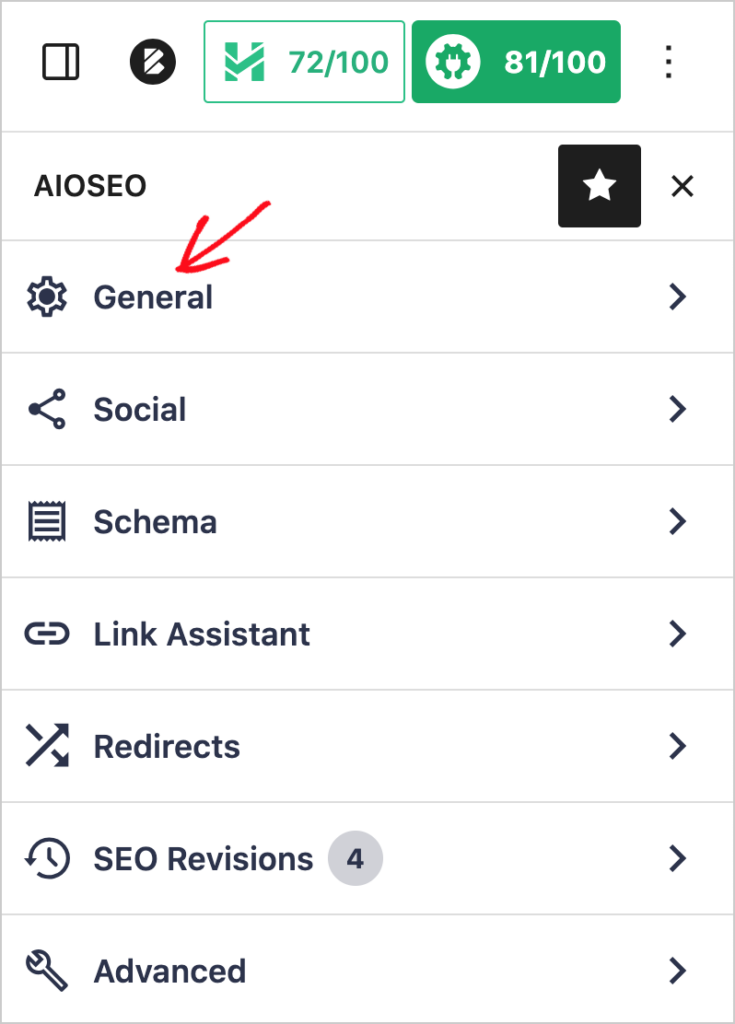
Here, we’ll find AIOSEO’s action steps to improve our page’s SEO.
We’ll start by optimizing a search snippet.
Step 2: Optimize Your Search Snippet
First, click on the Edit Snippet button.
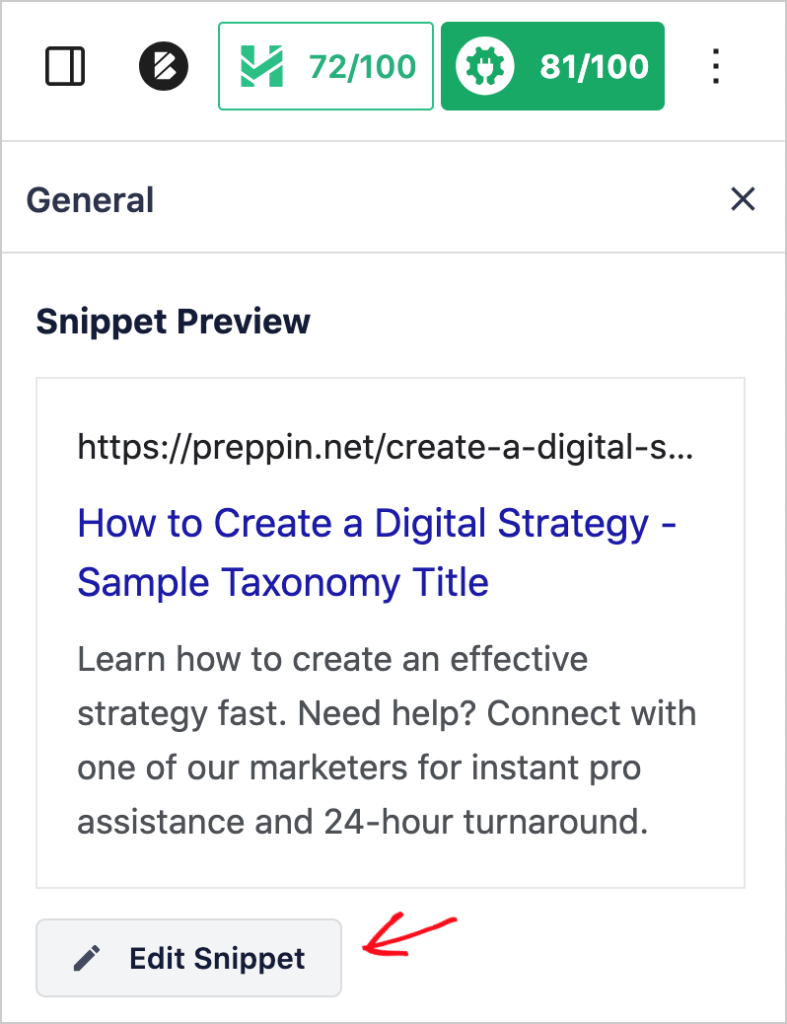
That will open a small popup window that shows what your page, once published, may look like in Google search results. This is called the Snippet Preview.

So, what’s a search snippet? When a published web page appears in Google search results, the display is called a search snippet. A search snippet includes a title, description, and link.
Now, back in your WordPress editor, look below AIOSEO’s search snippet preview.
You’ll see a field where you can enter a title.
Below that, there’s a field to enter a description. (In SEO, your page description is called a “meta description.”)
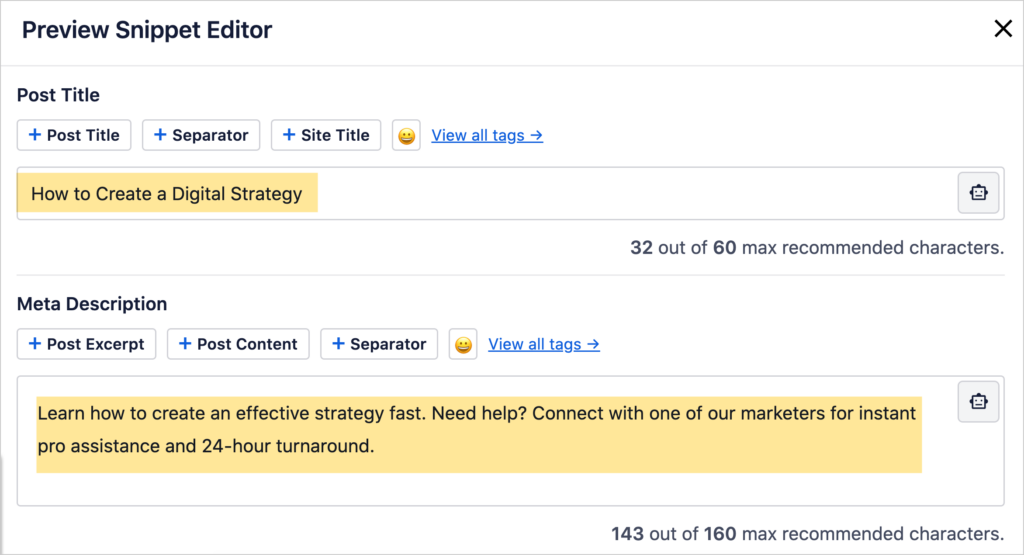
Below each field, you’ll see a number. This number is the approximate character limit, after which Google cuts off your title or description due to space constraints.
- Titles are cut off after approximately 60-65 characters.
- Meta descriptions are cut off after around 160 characters.
Best Practices for SEO Titles and Meta Descriptions
Because your title and description appear in search results, they’re your best opportunity to attract users to click on your page link.
- Make your title and description precise.
- State what’s unique about your page.
- Include your focus keyphrase in both.
Pro tip: Marketers often exceed the 60-character limit to include an extra keyword. You can choose to do the same, but remember that last keyword may wind up truncated.
Learn more about how to set your title and optimize your meta description.
Optimize Your URL
To optimize your URL, make sure it includes your focus keyphrase.
If your page title includes your focus keyphrase, it’ll automatically be added to your URL.
Remember: Your title, meta description, and URL should all include your focus keyphrase.
And that brings us to our next check. All in One SEO analyzes your page for the presence of your focus keyphrase.
Let’s learn more.
Step 3: Check Focus Keyphrase Use
Going back to the AIOSEO sidebar, click on Focus Keyphrase.
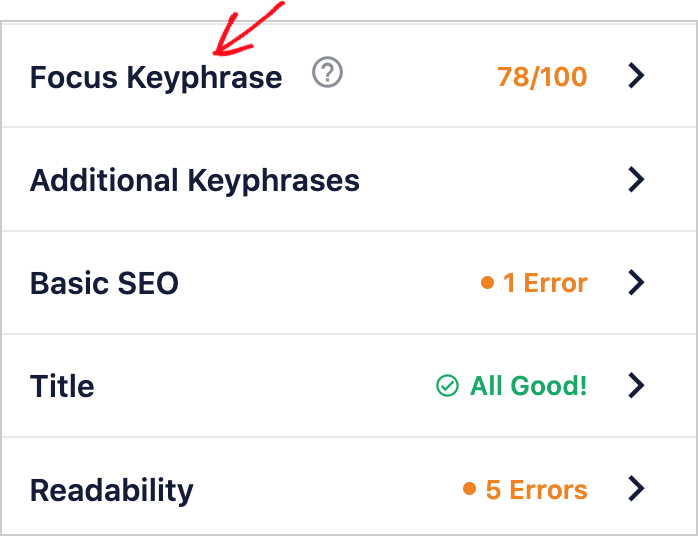
In the blank field, enter your focus keyphrase and click the Add Focus Keyphrase button to save.

Now, AIOSEO will check to see if your focus keyphrase is included in the following areas.
- Title, meta description, URL
- Some subheadings
- Some image alt attributes. (More on this later.)
If your focus keyphrase is missing from these areas, you’ll be prompted to add it.

Step 4: Add Links
Returning to the AIOSEO sidebar, let’s click on Basic SEO.
Here, you’ll see a recap of the previously discussed items. And 2 link items.
- Internal links
- External links
Adding relevant internal links to your page can help visitors find what they want.
In addition, internal links can help pages rank higher.
If your page has no internal links, AIOSEO will prompt you to add at least 1.

What about external links? External links (links to other websites) are not ranking factors. But, if you’re sharing statistics, claims, or quotations, citing your sources via a link can help generate trust in your content — if the link is to a trustworthy site.
While AIOSEO will check your page for the presence of external links, it’s not mandatory to add them. Use your judgment. Consider what’s helpful to the reader.
Okay, now that you’ve optimized your search snippet, checked focus keyphrase use, and added an internal link or 2, what’s next?
Let’s do a readability check.
Step 5: Improve Readability
All in One SEO’s readability checks will ensure your content’s easy to read online and formatted for scanning.
This means using plain language and breaking up long text passages with subheadings, images, or other items that make reading on digital screens more pleasant.
In the AIOSEO sidebar, click on Readability.
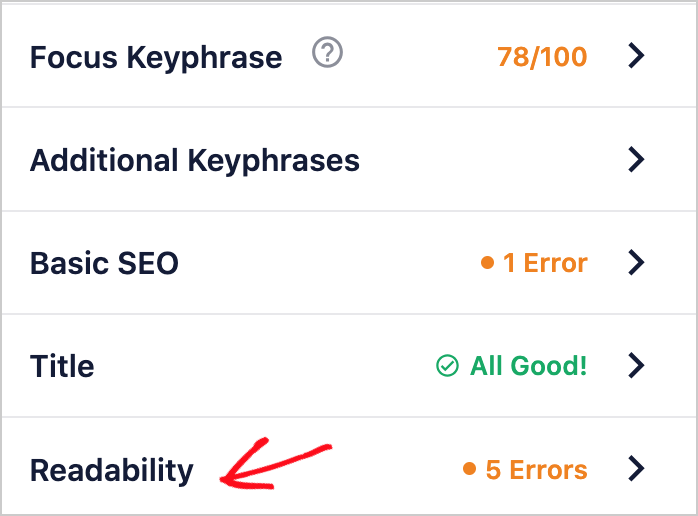
Here, you’ll see what you’re doing well.
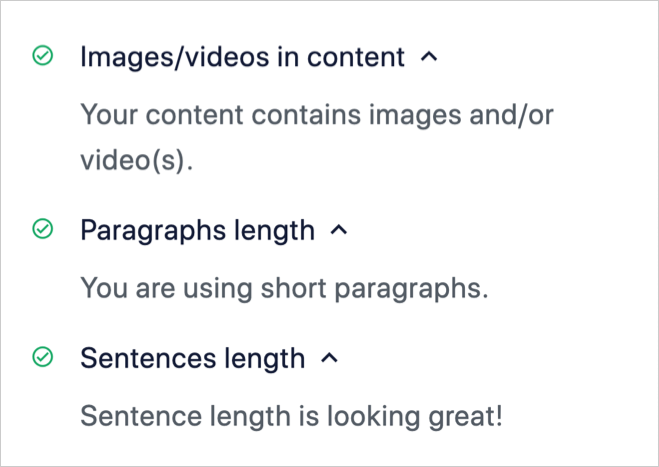
And what could use improvement.
Below, AIOSEO tells us we have a long text passage that needs another subheading.

Click the eye icon, and the portion of text that needs a new subheading will be highlighted in blue.
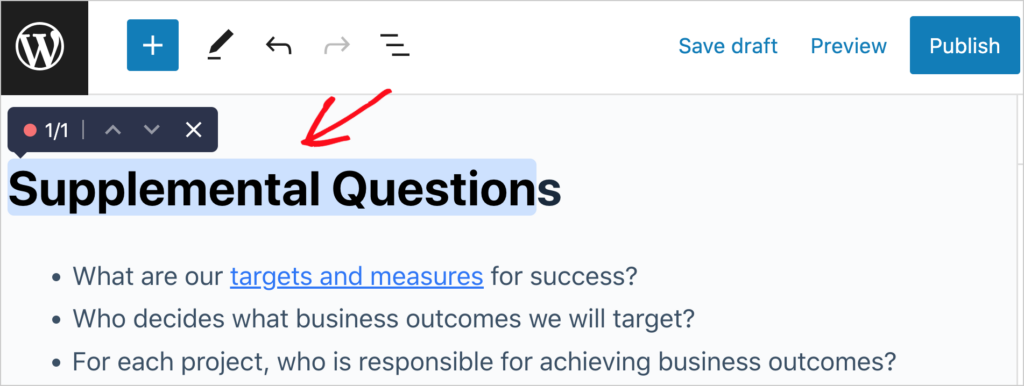
You can immediately locate the passage that needs another subheading.
What’s Included in the Readability Checks?
Curious what’s included in the readability checks? All in One SEO will analyze these items:
- Images/videos in content: Relevant media can add value and break up long text passages.
- Length of paragraphs and sentences: Short paragraphs and sentences are easier to read.
- Passive voice: You’ll be prompted to change instances of the passive voice to the active voice.
- Transition words: If these are absent, you’ll be encouraged to add some.
- Consecutive sentences that begin with the same word: This can make a page awkward or boring to read.
- Subheading distribution: You’ll be prompted to add subheadings to long text passages. This makes reading on digital screens easier.
- Flesch Reading Ease Score: The higher the score, the better.

Congratulations!
Congratulations! You’ve completed this SEO for beginners tutorial.
Remember: simply check the AIOSEO sidebar and follow the instructions. As you act on the plugin’s recommendations, you’ll see your SEO score go up.
This reinforces good SEO habits. At the same time you’ll be learning SEO by doing it.
Before we move on to Q&A, let’s look at how you can ensure your pages look great on social media.
Optimize Your Page for Social Media
Have you ever shared a page on social media only to be disappointed because something was missing? Maybe no image displayed. Or the description was missing.
With All in One SEO, you can control how your pages appear on social media.
It’s easy. Follow these instructions to optimize your page for Facebook and Twitter.
Q&A on SEO for Beginners
You probably have lots of questions about SEO. We’ve answered some of the most common questions we receive from beginners.
If you have another question, please share it in the comments below. Our team of SEO professionals will be delighted to be of assistance.
Do I need a sitemap?
Adding a sitemap to your website is a best practice. Creating and regularly updating a sitemap can help Google discover and index your site content.
Google recommends using 2 sitemaps: an XML sitemap and an RSS sitemap. An XML sitemap is a complete listing, in XML code, of all your site content. An RSS sitemap is smaller and lists only recently modified or newly published content. Google will crawl your RSS sitemap quickly and more frequently than your XML sitemap.
All in One SEO (AIOSEO) automatically generates (and updates) XML and RSS sitemaps for you. No further action is needed on your part, but we do recommend submitting your sitemap to Google.
Can I learn SEO in a week?
You can learn basic SEO in a week using an SEO plugin like All in One SEO (AIOSEO). The plugin will guide you and handle technical tasks for you.
Keep in mind that SEO has a range of practices, from basic to advanced. For instance, some SEO professionals specialize in creating content that generates revenue. Other SEO professionals are software engineers who solve complex code issues. Naturally, advanced skills can’t be learned in a week.
That said, if you commit to using an SEO plugin like All in One SEO, following the basics will yield surprising results.
Can I learn SEO without coding?
Yes, you can learn SEO without coding. Software plugins, such as All on One SEO (AIOSEO), execute SEO-related code for you while you simply click buttons and fill out form fields.
It’s unnecessary to know code or have any technical knowledge to optimize pages for SEO.
What are rich snippets?
Rich snippets are web pages that have schema markup code added to them. This code adds invisible tags to your content to help Google understand it better. As a result, your page becomes eligible to be displayed as a rich snippet in Google search engine results pages (SERPs.) Additionally, it may rank for more keywords.
Many (but not all) rich snippets appear as large search engine displays. For example, here’s a standard search snippet.

And here’s a rich snippet.

There are many styles of rich snippets for products like these, which look similar to ads.
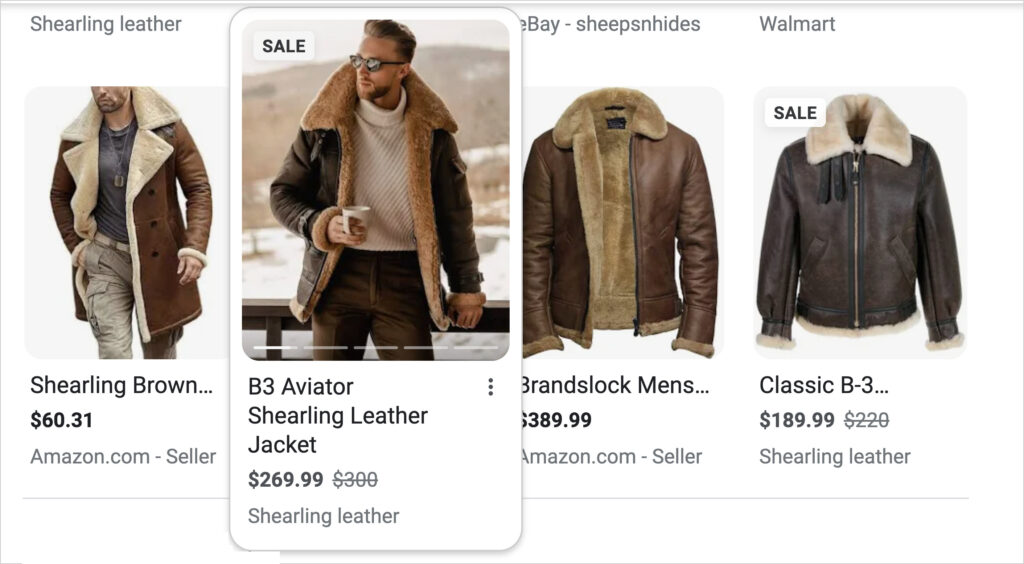
Some rich snippets will add only a small amount of extra information to search results. But it’s still worth using rich snippets because they help your page rank for relevant queries and attract more click-throughs.
How can I get rich snippets?
The easiest way to turn your web page into a rich snippet is to use an SEO plugin like All in One SEO (AIOSEO).
You’ll click a few buttons and fill out some form fields. The plugin gives you a choice of different schema types to add, like book, event, courses, datasets, and more. Learn how to use AIOSEO to add rich snippets.
What is on-page SEO?
On-page SEO is a term marketers use to describe optimizing a single page to perform better in search engine results. It entails best practices for titles, meta descriptions, links, and keyword use.
SEO plugins like All in One SEO (AIOSEO) include readability checks. These checks guide users to create content that’s easy and enjoyable to read online. While content quality is the #1 ranking factor, readability may not directly impact SEO. However, research has shown it significantly impacts engagement and reader satisfaction.
On-page SEO is the opposite of off-page SEO. The latter describes digital PR tactics that may help pages rank and drive traffic. These tactics include acquiring customer reviews, backlinks, and mentions in major media.
Resources on SEO for Beginners
We’re confident you’ll catch on fast as you use the All in One SEO plugin. Learning SEO by doing it, makes the process easy and fun.
Once you’re ready to move on from the basics, here are some areas to consider exploring.
Link Building: When trusted sites link to yours, those backlinks may boost your rankings, traffic, and revenue.
Read our Ultimate Guide to Link Building for ideas on getting backlinks.
Keyword Research: We mentioned that doing keyword research can help your pages rank higher. This is particularly true if you choose keywords that are easy to rank for.
- Learn how to check keyword difficulty scores.
- Explore this beginner’s guide to keyword research.
- And get a simple introduction to search intent.
Tutorials: Subscribe to our YouTube Channel for new tutorials each week. These are short and easy-to-understand.
Also follow us on X (Twitter), LinkedIn, or Facebook to stay in the loop.
Disclosure: Our content is reader-supported. This means if you click on some of our links, then we may earn a commission. We only recommend products that we believe will add value to our readers.

